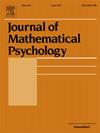Conjugate Bayesian analysis of the Wald model: On an exact drift-rate posterior
IF 1.5
4区 心理学
Q2 MATHEMATICS, INTERDISCIPLINARY APPLICATIONS
引用次数: 0
Abstract
In cognitive psychology, simple response times are often modeled as the time required by a one-dimensional Wiener process with drift to first reach a given threshold. This stochastic process’s first-passage time follows a Wald distribution, which is a specific parameterization of the inverse-Gaussian distribution. It can be shown that the Gaussian-Gamma distribution is a conjugate prior with respect to an inverse-Gaussian likelihood, albeit under a parameterization different from that of the Wald distribution. This leads to a posterior distribution that does not directly correspond to the core parameters of the Wiener process; that is, the drift-rate and the threshold parameter. While the marginal threshold posterior under a Gaussian-Gamma prior is relatively easy to derive and turns out to be a known distribution, this is not the case for the marginal drift-rate posterior. The present work addresses this issue by providing the exact marginal posterior distributions of the drift-rate parameter under a Gaussian-Gamma prior—something that has not yet been done in the literature. Unfortunately, the probability density function of this distribution cannot be expressed in terms of elementary functions. Thus, different methods of approximation are discussed as an expedient for time-critical applications.
沃尔德模型的共轭贝叶斯分析:精确漂移率后验
在认知心理学中,简单的反应时间通常被建模为具有漂移的一维维纳过程首次达到给定阈值所需的时间。该随机过程的首次通过时间遵循Wald分布,这是反高斯分布的特定参数化。可以证明,高斯-伽马分布是相对于反高斯似然的共轭先验,尽管在参数化下与瓦尔德分布不同。这导致后验分布不直接对应于维纳过程的核心参数;即,漂移率和阈值参数。虽然在高斯-伽玛先验下的边际阈值后验相对容易推导,结果是一个已知的分布,但对于边际漂移率后验来说,情况并非如此。目前的工作通过在高斯-伽玛先验下提供漂移率参数的精确边际后验分布来解决这个问题-这在文献中尚未完成。不幸的是,这个分布的概率密度函数不能用初等函数来表示。因此,讨论了不同的近似方法,作为时间关键应用的权宜之计。
本文章由计算机程序翻译,如有差异,请以英文原文为准。
求助全文
约1分钟内获得全文
求助全文
来源期刊

Journal of Mathematical Psychology
医学-数学跨学科应用
CiteScore
3.70
自引率
11.10%
发文量
37
审稿时长
20.2 weeks
期刊介绍:
The Journal of Mathematical Psychology includes articles, monographs and reviews, notes and commentaries, and book reviews in all areas of mathematical psychology. Empirical and theoretical contributions are equally welcome.
Areas of special interest include, but are not limited to, fundamental measurement and psychological process models, such as those based upon neural network or information processing concepts. A partial listing of substantive areas covered include sensation and perception, psychophysics, learning and memory, problem solving, judgment and decision-making, and motivation.
The Journal of Mathematical Psychology is affiliated with the Society for Mathematical Psychology.
Research Areas include:
• Models for sensation and perception, learning, memory and thinking
• Fundamental measurement and scaling
• Decision making
• Neural modeling and networks
• Psychophysics and signal detection
• Neuropsychological theories
• Psycholinguistics
• Motivational dynamics
• Animal behavior
• Psychometric theory
 求助内容:
求助内容: 应助结果提醒方式:
应助结果提醒方式:


